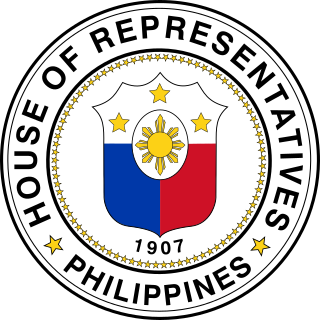
The House of Representatives of the Philippines is the lower house of the Congress of the Philippines. It is commonly referred to as the Congress, the House of the People, and informally referred to as the Cámara or Kamara.
The legislative districts of Agusan del Norte are the representations of the province of Agusan del Norte and the highly urbanized city of Butuan in the various national legislatures of the Philippines. The province and the city are currently represented in the lower house of the Congress of the Philippines through their first and second congressional districts.
The legislative districts of Agusan del Sur are the representations of the province of Agusan del Sur in the various national legislatures of the Philippines. The province is currently represented in the lower house of the Congress of the Philippines through its first and second congressional districts.
The legislative district of Aurora is the representation of the province of Aurora in the various national legislatures of the Philippines. The province is currently represented in the lower house of the Congress of the Philippines through its lone congressional district.
The legislative districts of Albay are the representations of the province of Albay in the various national legislatures of the Philippines. The province is currently represented in the lower house of the Congress of the Philippines through its first, second, and third congressional districts.
The legislative district of Baguio is the representation of the highly urbanized city of Baguio in the various national legislatures of the Philippines. The city is currently represented in the lower house of the Congress of the Philippines through its lone congressional district.
The legislative district of Benguet is the representation of the province of Benguet in the various national legislatures of the Philippines. The province is currently represented in the lower house of the Congress of the Philippines through its lone congressional district.
The legislative district of Ifugao is the representation of the province of Ifugao in the various national legislatures of the Philippines. The province is currently represented in the lower house of the Congress of the Philippines through its lone congressional district.
The legislative district of Camiguin is the representation of the province of Camiguin in the various national legislatures of the Philippines. The province is currently represented in the lower house of the Congress of the Philippines through its lone congressional district.

The legislative districts of Bukidnon are the representations of the province of Bukidnon in the various national legislatures of the Philippines. The province is currently represented in the lower house of the Congress of the Philippines through its first, second, third, and fourth congressional districts.
The legislative districts of Ilocos Norte are the representations of the province of Ilocos Norte in the various national legislatures of the Philippines. The province is currently represented in the lower house of the Congress of the Philippines through its first and second congressional districts.
The legislative districts of Ilocos Sur are the representations of the province of Ilocos Sur in the various national legislatures of the Philippines. The province is currently represented in the lower house of the Congress of the Philippines through its first and second congressional districts.
The legislative districts of Sulu are the representations of the province of Sulu in the various national legislatures of the Philippines. The province is currently represented in the lower house of the Congress of the Philippines through its first and second congressional districts.
The legislative district of Davao del Sur is the representation of the province of Davao del Sur in the various national legislatures of the Philippines. The province is currently represented in the lower house of the Congress of the Philippines through its lone congressional district.
The legislative district of Iloilo City is the representation of the highly urbanized city of Iloilo in the various national legislatures of the Philippines. The city is currently represented in the lower house of the Congress of the Philippines through its lone congressional district.
The legislative district of Occidental Mindoro is the representation of the province of Occidental Mindoro in the various national legislatures of the Philippines. The province is currently represented in the lower house of the Congress of the Philippines through its lone congressional district.
The legislative districts of Palawan are the representations of the province of Palawan and the highly urbanized city of Puerto Princesa in the various national legislatures of the Philippines. The province and the city are currently represented in the lower house of the Congress of the Philippines through their first, second, and third congressional districts.
The legislative districts of Misamis Occidental are the representations of the province of Misamis Occidental in the various national legislatures of the Philippines. The province is currently represented in the lower house of the Congress of the Philippines through its first and second congressional districts.
The legislative district of Lapu-Lapu is the representation of the highly urbanized city of Lapu-Lapu in the Congress of the Philippines. The city is currently represented in the lower house of the Congress through its lone congressional district.

Abra's at-large congressional district refers to the lone congressional district of the Philippines in the province of Abra. Abra has been represented in the country's various national legislatures since 1898. The first congressional delegation consisted of two members in the First Philippine Republic legislature known as the Malolos Congress. Since 1919 when it was re-established as a regular province separate from Ilocos Sur, Abra has been entitled to one member in the House of Representatives of the Philippines, elected provincewide at-large, except for a brief period between 1943 and 1944 when it was again represented by two members in the National Assembly of the Second Philippine Republic. From 1978 to 1984, all provinces were converted into multi-seat regional at-large districts for the Interim Batasang Pambansa of the Fourth Philippine Republic, with Abra forming part of the twelve-seat Region I's at-large district. It was restored as a single-member district in 1984.



